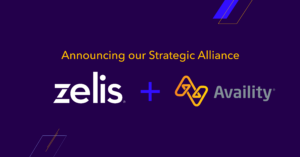
By Amanda Eisel
Amanda Eisel has focused the last 20 years of her career at the intersection of healthcare and technology. She has been deeply involved creating and scaling multiple growth technology companies including Waystar, Applied Systems and Viewpoint. Amanda has been a member of the Zelis team since 2019, playing a leadership role across Zelis’ growth, operational and talent strategies. Amanda started her career at McKinsey & Company, where she spent nearly a decade advising consumer companies. Prior to Zelis, Amanda was an Operating Partner at Bain Capital focused on technology and healthcare IT companies.
Hello there. If you’ve read my blogs before, you would have heard me talk about the Zelis mission. That mission states, “We seek to harmonize the complete payment process in healthcare by paying for care, with care.”
We chose the word harmonize in our mission deliberately. Let’s look at what it means:
Harmonize verb, har•mo•nize
1. to bring into consonance or accord
2. to be in agreement in action, sense, or feeling
As both a healthcare consumer and as someone who works in the industry, I’m acutely aware that the system is not as harmonious as it could be. In fact, it often operates with great discord. The interests of participants are not alignedand the experience for everyone suffers as a result.
The definition of harmony – in terms of our Zelis strategy – is to bring together the various stakeholders in healthcare – payers, providers, and members (or consumers) to deliver a better financial experience for all.
Our very purpose is to make healthcare more affordable and transparent – with a careful, methodical approach to removing points of friction in the system.
Announcing the Zelis Harmonization Index
At Zelis, we believe so deeply in achieving harmony that we commissioned a third-party study to measure the maturity curve of harmony in the healthcare financial experience: The Payment Harmonization Index. Our first installment of this intended evergreen index surveyed payers to understand how their actions enable, or detract from, systemic harmony. The study was an anonymous opt-in market research survey of 214 payer executives conducted by the Aite-Novarica Group. These executives had responsibility for the following functions: Networks, Claims, Payments, and Member Engagement. Our questions focused on how much the payers’ actions enabled Accuracy, Clarity, Collaboration, Precision, and Speed, with the assertion that the more the payers drive these outcomes, the more harmonious the financial experience will be.
The index itself is a score assigned to each respondent that measures the difference between their answers and the best practice or “ideal” state. With this sampling of the industry, we’re able to extrapolate that to the whole and get an idea of the distribution of harmony enablement from “best in class” to “efficient” to “lagging”.
Aite-Novarica has just released the findings to the market and we’ve made the report available on our website, but perhaps the most exciting aspect of this ambitious project is the ability for each organization to complete a personalized diagnostic to learn how they benchmark against their industry peers. With that information, the organization can view very prescriptive actions that will improve their contribution to healthcare payments harmony. These diagnostics will be published alongside deep-dive analytical reports released periodically over the next year, with the first one – payments optimization – available in July.
The drivers of harmony
Through this study, we’ve identified five drivers of harmony – each mapped to the business aspects of the healthcare experience. Essentially, the more we do of these things, the better the outcome for everyone:
- Collaboration – both internally among departments and externally with providers
- Clarity – of choice and communications for members
- Precision – driven by data and analytics
- Accuracy – with claim and bill reviews performed pre-payment
- Speed – enabled by electronic payments and automation
Looking ahead
We often use phrases like, “removing friction from the system,” or “easing adversarial relationships.” But this is corporate language. In real speak, what we mean is that the whole process needs to be more collaborative in the mutual best interest of all – smoother, easier to understand, and to navigate.
Why? Because to healthcare consumers, the financial experience isn’t separated from the clinical one, and it has just as much impact on wellbeing. Forbes reports that 50% of Americans currently have medical debt, and 46% of those bills have gone to collections according to recent data from Debt.com. Even in the midst of the pandemic, Americans have been more worried about paying for Covid-19 care than getting sick from the virus. The Sycamore Institute has found that medical debt itself can affect health outcomes, exacerbate already poor health outcomes, and worsen existing health disparities.
Ideally, the No Surprises Act will create greater harmony in the system by reducing the stresses associated with surprise medical bills – but it’s not just patients who suffer from a lack of harmony.
The healthcare workforce has faced unbelievable disruption during and through the pandemic. Data suggests that the country is on the brink of a turnover wave in the healthcare workforce, with the AMA reporting that 1 in 5 physicians and 2 in 5 nurses intend to leave their current practice within the next 2 years. Administrative workers, especially hourly employees, have faced financial hardship amidst ballooning inflation, lay-offs, and childcare closures. Complex processes that make it more difficult for an already-strained workforce only exacerbate existing problems and make it even more difficult to deliver care.
As humans, we naturally seek harmony in our lives – it’s one of the reasons why we enjoy music or a walk along the beach or watching a well-choreographed dance routine. Harmony makes us feel good, it gives us comfort and a feeling of inner peace knowing that things are aligned and functioning smoothly. Simply put, harmony is good for our health. It’s time to bring healthcare together to move forward as one.
Download the report to find out how. If you have questions, reach out to your Zelis representative to learn more, get your own harmonization score, and map out how you can contribute to a more harmonious future.
Until next time, stay well.



